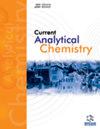来自阿尔及利亚撒哈拉沙漠的真菌 Lawsonia inermis:叶中 Lawsone 的定量分析,特别关注其干燥条件
IF 1.7
4区 化学
Q3 CHEMISTRY, ANALYTICAL
引用次数: 0
摘要
介绍:随着商用鸡骨草(指甲花)粉末数量的不断增加,其质量差异也越来越大,因此有必要对其主要活性成分 lawsone 的含量进行验证和控制。本研究的目的是考察干燥对罗桑酮含量的影响。研究方法在不同温度(40°C、50°C 和 60°C)下以两种方式(空气干燥和溃疡干燥)干燥指甲花叶片。我们使用索氏提取器,分别以甲醇和水为溶剂,从叶片中提取律酮。通过薄层色谱(TLC)、高压液相色谱(HPLC)和紫外分光光度计对这种天然色素进行了分离、纯化和分析。结果干燥温度对提取率(Re)有很大影响。因此,低温干燥指甲花叶可以获得更高的律酮提取物产量。结论我们建议使用超声波辅助干燥指甲花叶,这样既能降低干燥温度以节约能源,又能提高律酮提取率。本文章由计算机程序翻译,如有差异,请以英文原文为准。
Lawsonia inermis from the Algerian Sahara: Quantitative Analysis of Lawsone in Leaves with Special Attention to their Drying Conditions
Introduction: The continuously growing number of commercial Lawsonia inermis (henna) powders and the wide variability of their quality necessitate verifying as well as controlling their level of lawsone, the main active ingredient. The purpose of this study is to examine the effect of drying on the level of lawsone. Method: The leaves of henna were dried at different temperatures (40°C, 50°C, and 60°C) with both modes (air and ulrasons). We extracted lawsone from leaves by a Soxhlet extractor using methanol and water as solvents, respectively. This natural pigment was isolated, purified, and analyzed by thin-layer chromatography (TLC), high-pressure liquid chromatography (HPLC), and ultra-violet (UV) spectrophotometer. Result: The drying temperature highly affected the extraction yield (Re). Therefore, drying henna leaves at low temperatures allows for a higher yield of lawsone extracts. Conclusion: We recommend ultrasonically assisted drying of henna leaves to facilitate both the reduction of drying temperatures in order to conserve energy as well as the increase of the yield of lawsone extraction.
求助全文
通过发布文献求助,成功后即可免费获取论文全文。
去求助
来源期刊

Current Analytical Chemistry
化学-分析化学
CiteScore
4.10
自引率
0.00%
发文量
90
审稿时长
9 months
期刊介绍:
Current Analytical Chemistry publishes full-length/mini reviews and original research articles on the most recent advances in analytical chemistry. All aspects of the field are represented, including analytical methodology, techniques, and instrumentation in both fundamental and applied research topics of interest to the broad readership of the journal. Current Analytical Chemistry strives to serve as an authoritative source of information in analytical chemistry and in related applications such as biochemical analysis, pharmaceutical research, quantitative biological imaging, novel sensors, and nanotechnology.
 求助内容:
求助内容: 应助结果提醒方式:
应助结果提醒方式:


